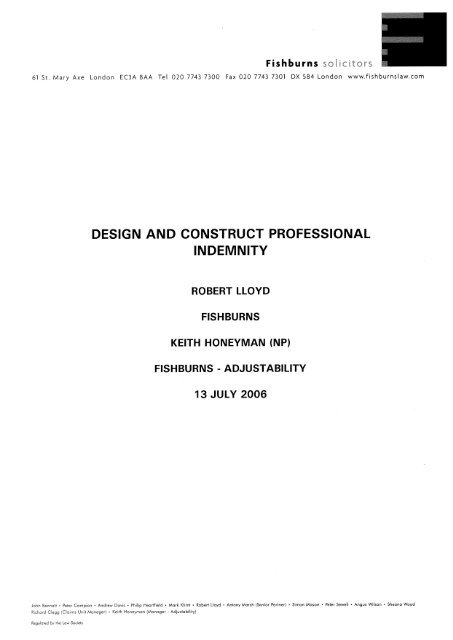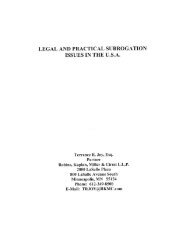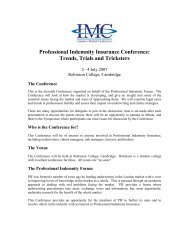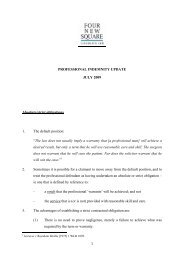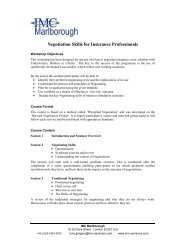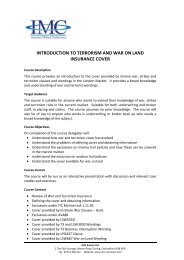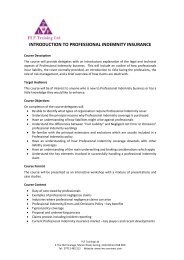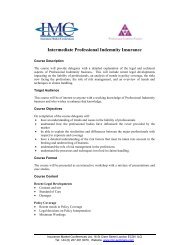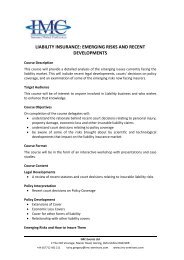design and construct professional indemnity - Insurance Market ...
design and construct professional indemnity - Insurance Market ...
design and construct professional indemnity - Insurance Market ...
You also want an ePaper? Increase the reach of your titles
YUMPU automatically turns print PDFs into web optimized ePapers that Google loves.
Fishburns hors<br />
61 St. Mary Axe London EC3A 8AA Tel 020 7743 7300 Fax 020 7743 7301 DX 584 London www.fishburnslaw.com<br />
DESIGN AND CONSTRUCT PROFESSIONAL<br />
INDEMNITY<br />
ROBERT LLOYD<br />
FISHBURNS<br />
KEITH HONEYMAN (NP)<br />
FISHBURNS - ADJUSTABILITY<br />
13 JULY 2006<br />
John Bennett • Peter Campion • Andrew Davis - Philip Heartfield - Mark Klimt • Robert Lloyd • Antony Marsh (Senior Partner) - Simon Mason - Peter Sewell • Angus Wilson - Sheona Wood<br />
Richard Clegg (Claims Unit Manager) - Keith Honeyman (Manager - Adjustability)<br />
Regulated by the Law Society
DESIGN AND CONSTRUCT PROFESSIONAL<br />
INDEMNITY<br />
ROBERT LLOYD<br />
FISHBURNS<br />
KEITH HONEYMAN (NP)<br />
FISHBURNS - ADJUSTABILITY<br />
13 JULY 2006<br />
The object of this talk is to:<br />
1 Explain what is the cover provided;<br />
2 Explain how it is different from other <strong>professional</strong> policies;<br />
3 Suggest how these differences could practically affect the conduct of<br />
claims' h<strong>and</strong>ling <strong>and</strong> disputes.<br />
Most importantly it is to explain how with such policies the cover is critical <strong>and</strong><br />
awareness of its scope <strong>and</strong> limits could easily make the difference between a<br />
disaster <strong>and</strong> a problem.<br />
However, it is first necessary to consider some preliminary questions to provide<br />
context.<br />
This can be addressed by looking at three questions:<br />
Q1 Why do Contractors need Design <strong>and</strong> Construct Professional Indemnity?<br />
Q2 How do <strong>design</strong> liabilities arise?<br />
Q3 What is the relationship to other liabilities?
WHY DO CONTRACTORS NEED DESIGN AND<br />
CONSTRUCT PROFESSIONAL INDEMNITY?<br />
1.1. The trite answer to this question is that Contractors need Professional<br />
Indemnity because Employers insist on them as a condition of Design <strong>and</strong><br />
Construct contracts. It is now also the default position written into the<br />
JCT Design <strong>and</strong> Build Contract ("DB") 2005, Section 6.11-6.12.<br />
1.2. As well as being a trite answer it is also a little profound <strong>and</strong> significant.<br />
It should be noted that the need does not arise out of any statutory or<br />
<strong>professional</strong>/trade association requirements. It is market driven, in<br />
particular by the relative prevalence of D&C contracts in particular<br />
<strong>construct</strong>ion sectors. The greatest factor has been historical. Although<br />
D&C contracts have been used for decades they had a comparatively<br />
minor share of the <strong>construct</strong>ion market by value as recently as the early<br />
1990s. Now RICS describes it as the fastest growing procurement<br />
system <strong>and</strong> certainly now exceeds half the UK industry by value. This is<br />
an example of the classic 'S' curve model of the adoption of innovations<br />
or new products.<br />
1.3. The Contractors we are considering do not actually have <strong>design</strong> <strong>and</strong><br />
consulting departments who are active in preparing original architectural<br />
<strong>and</strong> engineering <strong>design</strong>s. In most cases, we will be considering a bought<br />
in <strong>design</strong> prepared by the Contractor's own consultants <strong>and</strong> subcontractors<br />
or a <strong>design</strong> inherited via novation. If so then the real<br />
responsibility for any <strong>design</strong> failures should fall on these "<strong>design</strong>ers" <strong>and</strong><br />
their own insurance. However, no properly advised client of the<br />
Contractor is going to rely on such a chain of liability <strong>and</strong> a reason for<br />
D&C is to eliminate that chain for the client's purposes. Regardless of real<br />
responsibility the contractor is to carry primary contractual responsibility<br />
<strong>and</strong> as such cannot just rely on a third parties' insurance.<br />
1.4. A further point of emphasis is that Contractors businesses <strong>and</strong> the<br />
responsibilities they assume have been undergoing rapid evolution <strong>and</strong><br />
extension at least among the most progressive <strong>and</strong> competitive sectors of<br />
70622 v1 2
the industry. "Design <strong>and</strong> Construct" doesn't completely capture these<br />
developments for the contract might now include non-traditional elements<br />
of supply, training, operation <strong>and</strong> maintenance <strong>and</strong> other activities. In<br />
fact D&C must now be seen as part of a spectrum of business support<br />
services which involves a far wider range of activity than is traditionally<br />
associated with getting a building put up. Examples of this abound in<br />
contracts under the PFI <strong>and</strong> also contracts currently let by Highways<br />
Authorities.<br />
1.5. The D&C Professional Indemnity Policy is not to be seen in isolation. The<br />
risks it relates to are not covered by other traditional insurance policies<br />
carried by contractors notably the Contractors All Risk <strong>and</strong>/or Employers<br />
<strong>and</strong> Public Liability policies which primarily cover damage to property or<br />
persons during the Works. Other risk management techniques employed<br />
by contractors including the use of bonds, sub-contractors' warranties,<br />
limitation of liability <strong>and</strong> margin may all prove ineffective against the kind<br />
of losses <strong>and</strong> claims which could arise from <strong>professional</strong> or <strong>design</strong> risks.<br />
There is therefore little alternative, but compliance with the client's<br />
requirement for <strong>professional</strong> <strong>indemnity</strong> cover. One alternative which may<br />
be available or required where the character of the project puts it outside<br />
the scope of existing or obtainable <strong>professional</strong> <strong>indemnity</strong> cover is singleproject<br />
insurance. An example might be a contract involving asbestos or<br />
nuclear risks.<br />
70622 v1 3
2. HOW DO CONTRACTORS' DESIGN LIABILITIES ARISE?<br />
2.1. First it is necessary to recall that there is a history going back to the<br />
1 960s of employers seeking "turnkey" contracts with the advantage of a<br />
one-stop shop for all <strong>design</strong> <strong>and</strong> build matters from conception to the<br />
finished articles. This type of contract has been called Design <strong>and</strong><br />
Construct, or Design <strong>and</strong> Build <strong>and</strong> also encompasses management<br />
contracting in which the Contractor doesn't himself <strong>design</strong> or build<br />
anything very much . Typically, the contractual obligations of a D&C<br />
contractor are contrasted with those of "traditional" building contracts<br />
where the employer is an intermediary between the contractor <strong>and</strong> the<br />
<strong>design</strong> <strong>professional</strong>s .<br />
Traditional building contracts, however, are not<br />
lacking in contractors/sub-contractors own <strong>design</strong> elements particularly<br />
for specialist piling, foundations <strong>and</strong> steelwork .<br />
Therefore contractors<br />
<strong>design</strong> liabilities are not novel <strong>and</strong> this aspect of their work still<br />
constitutes an important proportion of the risk they run.<br />
70622 v1 4
2.2. St<strong>and</strong>ard Design <strong>and</strong> Construct contracts exist. Large utilities <strong>and</strong> other<br />
regular Employers often use their own one. The best known include the<br />
JCT St<strong>and</strong>ard Form of Building Contract with Contactor's Design 1998<br />
Edition ( various amendments were added to 2003).<br />
2.3. This has now been superseded by the 2005 edition of the JCT DB<br />
Contract. The JCT also publishes a Design <strong>and</strong> Build Sub-Contract<br />
(2005) "DBSub/C"<br />
2.4. In the JCT DB 2005, the Contractors ' Obligations are set out in Section<br />
2.<br />
2.5. The key parts of Section 2 are attached with, for comparison, the 1998<br />
wording which will still be used for many current projects.<br />
2.6. Section 2.1.1 - "The Contractor shall carry out <strong>and</strong> complete the Works<br />
in a proper <strong>and</strong> workmanlike manner <strong>and</strong> in compliance with the Contract<br />
Documents, the Health <strong>and</strong> Safety Plan <strong>and</strong> the Statutory Requirements<br />
<strong>and</strong> for that purpose shall complete the <strong>design</strong> for the Works including<br />
the selection of any specifications for the kinds <strong>and</strong> st<strong>and</strong>ards of the<br />
materials, goods <strong>and</strong> workmanship to be used in the <strong>construct</strong>ion of the<br />
Works so far as not described or stated in the Employer's Requirements<br />
or Contractor's Proposals, <strong>and</strong> shall give all notices required by the<br />
Statutory Requirements. "<br />
And there is a <strong>design</strong> warranty as follows:<br />
2.7. Section 2.17.1 - " Insofar as its <strong>design</strong> of the Works is comprised in the<br />
Contractor's Proposals <strong>and</strong> in what the Contractor is to complete in<br />
accordance with the Employer's Requirements <strong>and</strong> these Conditions<br />
(including any further <strong>design</strong> required to be carried out by the Contractor<br />
as a result of a Change), the Contractor shall in respect of any<br />
inadequacy in such <strong>design</strong> have the like liability to the Employer, whether<br />
under statute or otherwise, as would an architect or, as the case may be,<br />
other appropriate <strong>professional</strong> <strong>design</strong>er holding himself out as competent<br />
to take on work for such <strong>design</strong> who, acting independently under a<br />
separate contract with the Employer, has supplied such <strong>design</strong> for or in<br />
70622 v1 5
connection with works to be carried out <strong>and</strong> completed by a building<br />
contractor who is not the supplier of the <strong>design</strong>."<br />
2.8. Sections 2.10 - 215 are significant because they deal with discrepancies<br />
within <strong>and</strong> between the Employer's Requirements, the Contractor's<br />
Proposals <strong>and</strong> Statutory Requirements in far greater clarity than any<br />
previous version of this contract. Section 2.11 is likely to be helpful.<br />
"Subject to clause 2. 15, the Contractor shall not be responsible for the<br />
contents of the Employer's Requirements or for verifying the adequacy of<br />
any <strong>design</strong> contained within them. "<br />
2.9. Nevertheless, should discrepancies in the Employer's Requirements be<br />
discovered during the Contract then the contractor has positive obligation<br />
to address them (sections 2.14-2.15).<br />
St<strong>and</strong>ard of Care/Fitness for Purpose<br />
2.10. Section 2.17.1 is the point of departure where <strong>professional</strong> <strong>design</strong><br />
liabilities must be distinguished from the Contractor's other liabilities. In<br />
this section the liability is equated to that of an architect or other<br />
<strong>professional</strong> <strong>design</strong>ers. This is a reference to the st<strong>and</strong>ard of care<br />
applicable to <strong>professional</strong> advisers <strong>and</strong> the st<strong>and</strong>ard achieved by ordinary<br />
competent <strong>professional</strong>s skilled in the relevant field of work, in this case<br />
building <strong>design</strong>. The Bolam test - Bolam v Frien Hospital Committee<br />
(1957 ) 1ALL ER118.<br />
2.11. This is very important because without this limitation, the Contractor is<br />
by law equated with a supplier of goods <strong>and</strong> services <strong>and</strong> held to offer an<br />
implied term that the <strong>design</strong> is fit for its purpose (as per the Sale of<br />
Goods <strong>and</strong> Services Act 1982, section 4(5)).<br />
2.12. Viking Grain Storage Ltd v TH White Installations Ltd [1985] 3 CONLR<br />
52,33BLR 103 is authority to the point that absent an express st<strong>and</strong>ard<br />
of care then a fitness for purpose type obligation is implied. The Judge,<br />
Davies J, was positively enthusiastic for the proposition:<br />
70622 v1 6
"... The virtue of an implied term of fitness for purpose is that it prescribes<br />
a relatively simple <strong>and</strong> certain st<strong>and</strong>ard of liability based on the<br />
reasonable fitness of the finished product irrespective of considerations of<br />
fault <strong>and</strong> of whether its unfitness derives from the quality of work or<br />
material or <strong>design</strong>"<br />
2.13. Comparing this with section 2.17.1 throws light on the tension between<br />
the requirements of tort law versus contract law which is characteristic of<br />
the whole problem of insurable risk in this field. Viewing the matter from<br />
a wider perspective than that of the st<strong>and</strong>ard JCT DB contract it might be<br />
noted that <strong>professional</strong> services are, with notable exceptions e.g. NHS<br />
medicine, normally supplied within an express contractual framework<br />
with a st<strong>and</strong>ard of care usually but not always expressed (if it is<br />
expressed) akin to the Bolam<br />
test. The theme of concurrent duties in<br />
tort <strong>and</strong> contract is not at all unique to the building professions but the<br />
issue has been most exposed there because the contracts were much<br />
more explicit as to the Employers Requirements than elsewhere. The<br />
same issues arise when other customers or clients also start to define<br />
their requirements more fully.<br />
Scope of Duty<br />
2.14. Section 2.17.1 of the JCT DB wording establishes the st<strong>and</strong>ard of care<br />
appropriate to <strong>design</strong> obligations, but we have only considered just one<br />
clause of the st<strong>and</strong>ard wording. The typical major building contract<br />
document contains far far more than the st<strong>and</strong>ard contract conditions <strong>and</strong><br />
apart from amendments there may be reams <strong>and</strong> reams of Employer's<br />
Requirements, Design Parameters, Contractor's Proposals, Programmes,<br />
Contract Sum Analysis, express warranties, vague statements of intent<br />
<strong>and</strong> much much more. All of these could have a bearing on the scope of<br />
the <strong>design</strong> obligations <strong>and</strong> the extent of the <strong>professional</strong> duties generally.<br />
The JCT DB 2005 Section 2.11 wording was a direct response to the<br />
decision of HHJ Seymour QC in Cooperative <strong>Insurance</strong> Society v Henry<br />
Boot Scotl<strong>and</strong> Limited (2003) CLJ 19 109 in which it was held that<br />
"completion of the <strong>design</strong>" included checking an employer's pre-existing<br />
70622 v1 7
<strong>design</strong> to be satisfied that it would produce a completed <strong>design</strong> capable<br />
of being <strong>construct</strong>ed.<br />
2.15. The adequacy of the pre-contract <strong>design</strong> is undoubtedly one of the most<br />
frequent issues to arise in disputes <strong>and</strong> it should certainly not be thought<br />
that the thinking which gave rise to Henry Boot can be laid to rest by<br />
Section 2.11 not least because it may be too simple for what employers<br />
actually want or the factual reality of developing an existing <strong>design</strong>.<br />
2.16. Underst<strong>and</strong>ing why the scope of the Contractor's <strong>design</strong> obligations<br />
needs careful review <strong>and</strong> management can be assisted by appreciation of<br />
the typical process by which the complete contract documentation is<br />
assembled <strong>and</strong> what in that context is meant by completion of the<br />
<strong>design</strong>. For this, I refer to Figure 2.<br />
Figure 2<br />
EVOLUTION OF THE CONTRACT DESIGN<br />
Acceptance of Contractor's Proposals<br />
,ir h t ,ct<br />
Employer r-Fngin cr J<br />
^ ^<br />
Revision of ERs/Design Parameters<br />
-------' ---- -"- -------- T ------ - --<br />
Novation<br />
Design<br />
Parameters^EmployePS Contract<br />
Negotiations<br />
Re uirements<br />
Desi n<br />
First Desi n 9<br />
TenderCentractors<br />
Proposals<br />
Value Engineering<br />
DB Aic,hitect/<br />
Conti actor Eng.neer<br />
Completion of Completion of<br />
<strong>design</strong> building<br />
Contract Sum<br />
Conditions<br />
Final Proposals<br />
2.17. The message of Figure 2 is that for the Contractor limiting responsibility<br />
to its interpretation of the "completion of the <strong>design</strong>" can easily be<br />
undermined because the Contractor is often deeply implicated with what<br />
went on before the Contract through their response to the Employer's<br />
Requirements. Even if the contract contains a term equivalent to Section<br />
70622 v1 $
2.1 1, it may be narrowly construed or in conflict with a representation or<br />
warranty. The <strong>design</strong> liability of a D&C Contractor will be in question if it<br />
does a poor job of reviewing the Employer' s Requirements <strong>and</strong> preparing<br />
the Contractor's Proposals. Given the time <strong>and</strong> commercial pressures of<br />
a competitive tender then it sometimes seems impressive that a good job<br />
is done in this respect. However, if a contractor is to be good at anything<br />
it should underst<strong>and</strong> what its contract requires <strong>and</strong> a thorough<br />
assessment of <strong>design</strong> obligations <strong>and</strong> risk should be integral to the whole<br />
tender process of any competent D&C Contractor.<br />
2.18. Nevertheless, it should be recognised thateven good procedures <strong>and</strong><br />
awareness of the assumed risks will not find out all problems. The D&C<br />
Contractor is often adopting the <strong>design</strong>s of others, either the Employer's<br />
consultants or his own consultants, <strong>and</strong> in addition there are the risks of<br />
<strong>design</strong> development or the need to change <strong>design</strong> during the contract to<br />
accommodate variations or site instructions which cannot be foreseen at<br />
the time of entering the contract. The whole scenario is one where the<br />
Contractor's liability can also arise unwittingly whether or not risk<br />
assessment procedures worked.<br />
2.19. This is also a situation where the contractor commits to specified<br />
"deliverables" amid a process which has critical contractual pressures,<br />
including the need to put forward the best bid <strong>and</strong> within which the<br />
opportunity to exercise a complete technical or <strong>professional</strong> assessment<br />
may be limited. Again, it might be noted that however common this is in<br />
the <strong>construct</strong>ion industry, it is not unique to it.<br />
70622 v1 9
3. WHAT IS THE RELATIONSHIP OF THE DESIGN LIABILITY<br />
TO THE CONTRACTOR'S OTHER LIABILITIES?<br />
3.1. The fitness for purpose obligation/performance requirements/guarantees.<br />
While the general fitness for purpose obligation might be limited in<br />
relation to "<strong>design</strong>" by clause 2.17.1 that does not mean there will be no<br />
fitness for purpose obligations in the Contract. There are likely to be<br />
within the specifications or <strong>design</strong> parameters any number of particular<br />
requirements that can be construed as absolute obligations in the<br />
Contract. Failure to achieve such requirements will put the Contractor in<br />
breach, but they might not put the actual "<strong>design</strong>er" in breach owing to<br />
the distinction in the st<strong>and</strong>ard of care.<br />
3.2. This is an area where management of the <strong>design</strong> <strong>professional</strong><br />
appointments is critical. The Consultant's appointment will not change<br />
the <strong>professional</strong> st<strong>and</strong>ard of care, but it can address the scope of the<br />
duty to have proper regard for the obligations of the Contractor.<br />
Consultants have to be aware of <strong>and</strong> be instructed on the basis of the<br />
requirements of the Main Contract.<br />
3.3. The same issue applies to sub-contractors. The JCT DB Sub/C (2005)<br />
requires compliance with the Main Contract (section 2.5), but subcontractors'<br />
<strong>design</strong> is also subject to the ordinary <strong>professional</strong> st<strong>and</strong>ard<br />
(section 2.13)<br />
3.4. Achieving a guaranteed level of performance may therefore be excluded<br />
from sub-contractors' <strong>and</strong> consultants' scope of duty, but if they give<br />
advice or represent that their <strong>design</strong>s will achieve a particular result then<br />
the difference is not so great. Even so the distinctions that are made<br />
between contractual performance <strong>and</strong> <strong>professional</strong> duties are definitely an<br />
important issue in the insurance of this type of risk.<br />
3.5. This was most clearly found <strong>and</strong> exposed in Exclusion 11 of the DCW1<br />
wording which excludes:<br />
70622 v1 10
"the giving by the Assured of any express warranty or guarantee which<br />
increases the Assured's liability but this exclusion shall not apply to<br />
liability which would have attached to the Assured in the absence of such<br />
express warranty or guarantee-.<br />
3.6. This type of take-give is typical of Design <strong>and</strong> Construct Professional<br />
Indemnity. This illustrates the tension between the offer to cover certain<br />
liabilities, but not others. It should also be noticed that other contractual<br />
liabilities get similar treatment in contemporary policies including<br />
penalties, liquidated damages <strong>and</strong> indemnities.<br />
3.7. Obligation to carry "out "the works in a workmanlike manner to an<br />
appropriate st<strong>and</strong>ard . Design <strong>and</strong> workmanship liability are often<br />
competing explanations of why something has gone wrong. In the<br />
traditional <strong>construct</strong>ion dispute this is the contested ground between the<br />
Contractor <strong>and</strong> consultant albeit the Employer might be representing the<br />
Contractor's position. In a D&C contract the terms of this contest are<br />
both within the Contractor's remit, but it remains a possible source of<br />
dispute with the Contractor' s Professional Indemnity Underwriters.<br />
3.8. A key aspect of how this difference manifests itself in the cover is in the<br />
need to define Professional Activities <strong>and</strong> Duties or sometimes<br />
Professional Business<br />
for which cover is granted by the Professional<br />
Indemnity Policy. It was also apparent in the qualification that holds in<br />
DCW1.<br />
"For the avoidance of doubt, Professional Activities <strong>and</strong> Duties do<br />
not include supervision by the Assured of its own or its subcontractors<br />
work where such supervision is undertaken in its<br />
capacity as Building or Engineering Contractor.<br />
3.9. The reason why old style building disputes were fiercely contested was<br />
because it is very difficult to separate workmanship from <strong>design</strong> <strong>and</strong><br />
<strong>professional</strong> supervision. There is no neat point of distinction between<br />
<strong>professional</strong> <strong>and</strong> non-<strong>professional</strong> work <strong>and</strong> on a case by case basis it<br />
might be a matter of opinion, custom or the facts on the day.<br />
Nevertheless, Underwriters will not be able to duck this issue <strong>and</strong> their<br />
70622 v1 11
definition of the distinction will aim at limiting cover to <strong>professional</strong><br />
activities <strong>and</strong> duties, but there is a great scope for debate as to how they<br />
should be identified <strong>and</strong> differences among Underwriters as to whose<br />
work they are ready to cover. However, whatever any individual's<br />
concept of the difference is there is no escaping the possibility of<br />
argument.<br />
3.10. Duty to Warn. Legally this is a comparatively complex area because in<br />
relation to a D&C contractor the subject matter of a duty to warn would<br />
be quite various <strong>and</strong> is not necessarily limited to warnings arising from<br />
contractual duties <strong>and</strong> not necessarily arising from <strong>professional</strong> duties.<br />
The most frequently cited authority Plant v Adams [1998] EWHC QB<br />
335, a Court of Appeal decision, disdained from going much further than<br />
confirming that it was "an aspect of the general duty to take reasonable<br />
care <strong>and</strong> skill".<br />
In other words it is just part of what is required<br />
<strong>professional</strong>ly to get a job done properly taking into account knowledge<br />
which might be required at any stage of the project.<br />
3.11. It has been noted that the breach in respect of a duty to warn will often<br />
be the omission of the warning. The giving of a warning is not a<br />
negligent act <strong>and</strong> therefore liability for the consequences only arises from<br />
some other breach of duty. In the D&C context the exercise of a warning<br />
will put the contract in conflict with itself often leading to extra cost,<br />
delay <strong>and</strong> the incurring of liquidated damages. Only a sub-set of the<br />
possible circumstances trigger a claim for breach of <strong>professional</strong> duties.<br />
3.12. There is a definite tendency now for D&C PI wordings to address cover<br />
for duty to warn. Typically this is to provide cover for certain species of<br />
duty to warn (eg contractual) in order to exclude by implication others (eg<br />
non-contractual).<br />
3.13. Obligation to complete the contract on time <strong>and</strong> at cost . Liability for<br />
liquidated damages <strong>and</strong> consequential losses can arise owing to<br />
contractual delay. A D&C contract internalises potential conflicts<br />
between completing the contract without delay <strong>and</strong> at the least cost <strong>and</strong><br />
the need to get the <strong>design</strong> right. In the traditional contract situation the<br />
70622 v1 12
Contractor seeks to recover any losses caused by a negligent <strong>design</strong>er<br />
from the Employer either by agreed variation or extension of time or if not<br />
agreed by a loss <strong>and</strong> expense claim. The D&C contract changes this<br />
situation entirely. It also alters the nature of the mitigation required in<br />
that the Contractor's obligations to complete the contract now includes<br />
provision of the revised <strong>design</strong> solution which may lead to a question of<br />
whether there is betterment.<br />
3.14. Underwriters' approach to liquidated damages <strong>and</strong> the consequences of<br />
delay is generally the same to apply to other aspects of contractual<br />
perf-or-mance which in this-case is akin to awarranty todeliver on time<br />
with fixed penalties in the event of failure. However, the problem of<br />
assessing the real reasons for delay <strong>and</strong> whether or not they are arising<br />
from breach of <strong>professional</strong> duties or instead commercial difficulties,<br />
programming errors or mismanagement of resources is a difficulty of the<br />
same type <strong>and</strong> magnitude as distinguishing workmanship issues from<br />
<strong>design</strong> issues.<br />
3.15. The same problems relate to the differentiation of pricing risks from<br />
<strong>design</strong> <strong>and</strong> other <strong>professional</strong> risks. The D&C contractor may be<br />
competitive <strong>and</strong> win contracts solely on the basis of the lowest tender,<br />
but if there is a subsequent cost overrun because the original <strong>design</strong> was<br />
insufficient or the programme was misjudged it may be suggested that<br />
the original cause was <strong>professional</strong> errors which again must be hard to<br />
separate from the commercial misjudgement. They can be the two sides<br />
of the same coin.<br />
3.16. The above list of obligations is not exhaustive. The D&C Contract still<br />
involves the Contractor in all the traditional liabilities <strong>and</strong> the <strong>design</strong><br />
obligation is an overlapping addition. The management of the traditional<br />
liabilities involve the Contractor in multiplicity of formal <strong>and</strong> informal<br />
techniques of risk management, including the use of performance bonds,<br />
warranties, insurance (Contractors All Risk), sub-contracting, limitations<br />
on liability including LADs, retention of risk, margin for both costs <strong>and</strong><br />
time. Successful D&C allows the <strong>design</strong> obligation to sit comfortably<br />
with the rest.<br />
70622 v1 13
3.17. One of the messages of this paper is to highlight the fact that for certain<br />
D&C Contracts, the Professional Indemnity Policy will not have the scope<br />
to cover the main contractual risks. Sometimes this may be apparent at<br />
the time of contract formation, but unfortunately not always. Where the<br />
"driver" of a Contract is a guarantee or performance requirement then the<br />
question may have to be addressed whether it is possible to effectively<br />
make the <strong>design</strong>er responsible for that achievement. Alternatively, if the<br />
chief challenge on a project is <strong>construct</strong>ability <strong>and</strong> it is discovered that<br />
the <strong>design</strong> adopted cannot be practically implemented to an adequate<br />
<strong>construct</strong>ion st<strong>and</strong>ard then again it will not be always possible to hold the<br />
<strong>design</strong>er responsible. Finally, if the financial <strong>and</strong> time requirements of a<br />
project are paramount then again the contractor may be driven to<br />
solutions or expedients in completing the Contract for which the <strong>design</strong>er<br />
cannot be responsible. In any of those situations the Design <strong>and</strong><br />
Construct Professional Indemnity Policy is more likely to disappoint the<br />
Insured than if those factors were not present. However, given that<br />
those kinds of factors are likely to be present in a fair proportion of<br />
projects then careful attention to the requirements of the policy is<br />
required by both Underwriters <strong>and</strong> Insured. On the one h<strong>and</strong><br />
Underwriters must not allow the interpretation of the policy to exp<strong>and</strong> to<br />
cover all the Insured's commercial imperatives. On the other h<strong>and</strong> the<br />
Insured has the power at the time of contract formation <strong>and</strong> through its<br />
appointment of <strong>professional</strong>s to "maximise" the scope of its activities<br />
which fairly fall to be protected by the policy. Fortunately, the interests<br />
at stake are mutual because an Insured that pays attention to such issues<br />
at the right time is effectively engaged in risk management <strong>and</strong> that is<br />
likely to be to the Underwriters' benefit 9 times out of 10.<br />
70622 v1 14
4. THE COVER.<br />
4.1. A study of the policy wording is the only place to start underst<strong>and</strong>ing the<br />
scope of <strong>and</strong> limitations of any cover. However, reference might also<br />
need to be made to the insurance proposal because the statements made<br />
in that document can affect cover as well. A good example relates to the<br />
declarations which are made of turnover connected to defined disciplines<br />
<strong>and</strong> types of work. If it is found that work has been undertaken in<br />
different disciplines not disclosed then the policy could be voided.<br />
4.2. An __interpretation - of- - -the cover should reflect what the Underwriter is<br />
trying to achieve .<br />
The most obvious point is that the Underwriter does<br />
not intend to pick up the ordinary <strong>construct</strong>ion <strong>and</strong> commercial risks of a<br />
project. Further the policy should not duplicate cover available on other<br />
policies. Nevertheless, to be of any value the policy has to reflect the<br />
reality of <strong>design</strong> <strong>and</strong> <strong>construct</strong> contracting <strong>and</strong> take account of the fact of<br />
bought in <strong>design</strong> <strong>and</strong> the fact that the Contractor is or was in a Contract<br />
with strict obligations.<br />
4.3. In the London <strong>Market</strong> the DCW1 wording might be regarded as the<br />
ancestor of other wordings currently available in the market. DCW1 is<br />
notable for its brevity <strong>and</strong> simplicity <strong>and</strong> its DNA can be found in all other<br />
D&C Professional Indemnity policies. Subsequent wordings show signs<br />
of drafting to address perceived ambiguities or insufficiencies of the<br />
wording. Underwriters also have exercised a degree of give <strong>and</strong> take to<br />
adjust the scope of the cover to improve their offer or their underwriting<br />
results. However, the wording has also to cope with the evolution of the<br />
<strong>design</strong> <strong>and</strong> <strong>construct</strong> industry which as stated in the introduction has<br />
tended to widen the scope of the activities undertaken <strong>and</strong> Underwriters<br />
have had to decide how to accommodate this trend if they are willing to<br />
do so. Most of all the difficulty of distinguishing <strong>professional</strong> risks from<br />
commercial risks is what drives the development of most attempts at<br />
redrafting. It can be questioned whether a completely satisfactory<br />
approach is attainable. If not then that is serious because this is so much<br />
more a prominent product now than it was in former times.<br />
70622 v1 15
Negligence of the Insured <strong>and</strong> its Consultants or Sub-Contractors<br />
4.4. The "COVERAGE " is restricted to negligence in relation to Professional<br />
Activities <strong>and</strong> Duties.<br />
"... the Underwriters hereby agree to indemnify the Assured for any sum<br />
or sums which the Assured may become legally liable to pay arising from<br />
any claim or claims first made against them during the Period of <strong>Insurance</strong><br />
stated in the Schedule as a direct result of negligence on the part of the<br />
Assured in the conduct <strong>and</strong> execution of the Professional Activities <strong>and</strong><br />
Duties as herein defined".<br />
In addition to this cover for the Insured's breach an additional extension is<br />
available for the Insured's sub-contractors or sub-consultants:-<br />
"2. The Underwriters will, subject to the terms, exclusions, conditions<br />
<strong>and</strong> endorsements of this Policy, indemnify the Assured in respect of<br />
liability arising out of any act of negligence by specialist <strong>design</strong>ers,<br />
consultants or sub-contractors of the Assured <strong>and</strong> enjoyed in the<br />
performance of the Professional Activities <strong>and</strong> Duties defined herein<br />
provided that the rights of recourse against such specialist <strong>design</strong>ers,<br />
consultants or sub-contractors are not waived or otherwise impaired".<br />
4.5. This is usually considered more than an optional extension <strong>and</strong> instead<br />
closer to an integral element of a Design <strong>and</strong> Construct Professional<br />
Indemnity Policy . In newer wordings it is often but not always drafted<br />
into the same main insuring clause covering the Insured ' s <strong>professional</strong><br />
activities . This is critical because it extends the class of persons whose<br />
activities are covered by the Policy <strong>and</strong> reflects the issue of bought-in<br />
<strong>design</strong>.<br />
4.6. It is one of the unique features of D&C Professional Indemnity policies<br />
that the above situation leads Underwriters to insure the <strong>professional</strong><br />
duties of <strong>construct</strong>ion industry consultants from whom they have never<br />
received a proposal form. In fact they do not know the identities let<br />
alone the character <strong>and</strong> record, of the parties whose activities they are in<br />
practice covering. This explains some aspects of the cover available as<br />
we shall see later in this paper.<br />
70622 v1 16
4.7. The definition of Professional Activities <strong>and</strong> Duties is also critical as it<br />
determines the type of activity that is insured. DCW1 initially covered:<br />
• Design or specification<br />
• Supervision of Construction (but not of own labour)<br />
• Feasibility Study<br />
• Technical Information Calculation<br />
• Surveying<br />
There is no cover for "similar" activities not listed although this rather<br />
restricted list was supplemented with additional activities by way of<br />
endorsement <strong>and</strong> newer wordings also have more extensive lists of<br />
covered activities. The covered activities are <strong>and</strong> should also be driven<br />
by declarations in the proposal form <strong>and</strong> along with turnover is an<br />
important factor in rating these risks.<br />
4.8. However, all these activities are excluded within the DCW1 definition if<br />
they are not undertaken "by or under the direct control of a properly<br />
qualified Architect, Engineer or Surveyor." A fundamental feature of the<br />
policy is that it only covers certain activities under the direction or control<br />
of certain types of persons. This definition in itself has not proved<br />
sufficient. Elaboration of the definition of "properly qualified" has<br />
generally been required usually by reference to experience in the relevant<br />
technical discipline (5 years usually) as an alternative to <strong>professional</strong><br />
qualification. Furthermore, as the list of insured activities is extended the<br />
reference to the three specific professions is less appropriate.<br />
4.9. There is a different approach to the definition of <strong>professional</strong> duties which<br />
is to relate it to the activities of technically qualified people <strong>and</strong> not<br />
directly define the type of work at all. This reflects the fact that in the<br />
most diverse of contracting organisations it is difficult to put a limit on<br />
the types of <strong>professional</strong> work which might be undertaken. This<br />
approach originates in the policies <strong>design</strong>ed to appeal to the largest<br />
contractors where it is hard to discover what they do not do.<br />
70622 v1 17
4.10. It should also be apparent that the extended definitions of Professional<br />
Activities <strong>and</strong> Duties or in other policies Professional Business shows that<br />
the idea that the policy is for "<strong>design</strong>" liabilities is rather misleading being<br />
much more extensive than that. Nevertheless, it ought to be asked<br />
whenever coverage comes to be considered whether the claim arose from<br />
properly qualified people doing one of the defined activities - or not.<br />
4.11. There is a final part of the definition of the insured activities which is<br />
expressed as a limit on the scope of Professional Activities <strong>and</strong> Duties<br />
which does not include the supervision of the Insured ' s own labour or its<br />
sub-contractors as noted at paragraph 3.8 above. This provision is at the<br />
heart of the point of controversy of workmanship <strong>and</strong> <strong>design</strong> <strong>and</strong> its<br />
invitation to disagreement. Whether you blame the words or the<br />
underlying concepts for the problem will determine if you might think<br />
major improvements could come from revising the terms of the cover.<br />
4.12. In this respect, I have had my attention drawn (thanks to Mike Earp <strong>and</strong><br />
Peter Ibbotson of Willis) to the Carey Syndicate 919 Design <strong>and</strong> Build<br />
Professional Indemnity Policy (circa 1985) which had no express<br />
exclusion for own labour supervision although it was not expressly<br />
included either. There was an evident intention to cover Project<br />
Managers <strong>and</strong><br />
"...other consultants or inspectors as would otherwise<br />
have been appointed by the Employer on the advise of or under the<br />
direction <strong>and</strong> control of the Architect or Consulting Engineer..." .<br />
There<br />
is in this what might be known as the "Clerk of Works Question" <strong>and</strong> an<br />
attempt to rationalise the D&C PI cover by comparison to the indemnities<br />
available to the parties to traditional contracts.<br />
4.13. Costs Prior to H<strong>and</strong>-Over.<br />
This is the second main component of the cover which in DCW 1 was also<br />
expressed as an additional extension to the policy:-<br />
"The Underwriters will, subject to the terms, exclusions, conditions <strong>and</strong><br />
endorsements of this Policy indemnify the Assured against the costs <strong>and</strong><br />
expenses necessarily incurred in respect of any action taken to mitigate a<br />
loss or potential loss that otherwise would be the subject of claim under<br />
70622 v1 18
this Policy. The onus of proving a claim under this Extension shall be<br />
upon the Assured who will be obliged to give prior written notice to<br />
Underwriters during the Period of <strong>Insurance</strong> of the intention to take action<br />
that will incur such loss"<br />
It is perhaps worth considering this with a more recent wording to show<br />
how much <strong>and</strong> how little this provision has evolved.<br />
"indemnify the Insured subject to notification in accordance with the<br />
Claims <strong>and</strong> Notification Provisions, which are conditions precedent to the<br />
provision of <strong>indemnity</strong>, for costs <strong>and</strong> expenses reasonably incurred with<br />
the prior written consent of [XXXJ which will not be unreasonably<br />
withheld in respect of rectifying prior to any practical completion , takeover<br />
certificate or defects period any part of the works <strong>construct</strong>ed by<br />
the Insured to the extent that the Insured is able to demonstrate on a<br />
balance of probabilities that the need for such rectification is due to the<br />
Insured's negligence in the conduct of their Professional Business <strong>and</strong> is<br />
necessary to mitigate a Claim or likely Claim that would otherwise have<br />
been insured under Clause 1 . 1. "<br />
4.14. This is a most interesting <strong>and</strong> highly charged aspect of the cover.<br />
Mitigation is, of course, not a strange concept in Professional Indemnity,<br />
but for all other types of Professional Indemnity it is usually the Insured<br />
who is raising the cry of mitigation against Claimant. In the case of a<br />
D&C Contractor it is he himself who is in a position to do the mitigating.<br />
The wording above betrays the anxiety of the Underwriter by placing the<br />
onus on the Insured to prove on the balance of probabilities the necessity<br />
of the mitigating action. The danger for the Underwriter is that the<br />
mitigation against <strong>professional</strong> negligence might be mixed up with all<br />
sorts of other mitigation connected to the progress of the Contract that<br />
ought not to be indemnified.<br />
4.15. The Insured needs to demonstrate there would be a claim under the<br />
policy although there is no need to wait for a loss to occur, just to<br />
demonstrate a potential loss within the scope of cover. Failure to obtain<br />
70622 v1 19
prior written consent will certainly result in no assurance of cover for<br />
mitigating steps taken before this is remedied <strong>and</strong> possibly an argument<br />
about any course of action taken to which the Contractor has become<br />
committed.<br />
4.16. When such a claim is presented an important question is how will the<br />
Contractor demonstrate an actual or potential loss justifying the proposed<br />
action <strong>and</strong> to distinguish the costs of mitigation from costs which could<br />
otherwise be incurred under the Contract. The difficulty of this will vary<br />
according to the situation, but in complicated situations it is not going to<br />
be easyat all. In controversial situationsthe Underwriter may need<br />
independent <strong>professional</strong> assistance to verify the contractor's proposals.<br />
Exclusions<br />
4.17. Exclusions define the cover as much as the insuring clauses . The DCW1<br />
st<strong>and</strong>ard exclusions are not excessively numerous<br />
( 1 1) but in reality they<br />
must for a long time, if not always, have been supplemented by<br />
exclusions through endorsements.<br />
4.18. As noted above the D&C PI exclusions will evince an intention to prevent<br />
the policy picking up the performance requirements <strong>and</strong> workmanship<br />
obligations which might be imposed by a D&C contract. These include:<br />
• contractual liability - fitness for purpose, warranties, guarantees<br />
<strong>and</strong> liquidated damages;<br />
• incorrect specification, estimates <strong>and</strong> programmes;<br />
both of these exclusions are qualified in that they will be covered if they<br />
arise from a breach of <strong>professional</strong> duty properly defined.<br />
• Unsupervised work<br />
• Workmanship/supervision<br />
4.19. More general commercial risks adopted by the D&C contractor are<br />
addressed by the following exclusions some of which may be negotiable<br />
to a degree:<br />
70622 v1 20
• Assignment of collateral warranties;<br />
• Maintenance of insurance <strong>and</strong> financial provisions or advice;<br />
• Consortia <strong>and</strong> joint ventures;<br />
• Binding adjudications;<br />
• Insolvency of Insured;<br />
4.20. There are exclusions relating to other insurance:<br />
• Employer's liability;<br />
• Occupier's liability;<br />
• Other insurance.<br />
4.21. Finally, there is a class of unacceptable risks:<br />
• Pollution (save for sudden, unexpected <strong>and</strong> accidental);<br />
• USA/Canada;<br />
• War/terrorism;<br />
• Toxic mould;<br />
• Products;<br />
• Asbestos;<br />
• Nuclear.<br />
Conditions<br />
4.22. In DCW1 the primary condition of note relates to claims notification. In<br />
this respect the wording was a perfectly typical clause of its type which<br />
could be found in identical form in any other P1 policy.<br />
The only particular<br />
twist was the additional requirement to give prior written notice <strong>and</strong><br />
demonstrate the necessity of actions to be indemnified via the mitigation<br />
extension.<br />
70622 v1 21
4.23. As with the DCW1 wording, it is normal for notification conditions to be<br />
conditions precedent in D & C P1 policies. The requirement is to notify<br />
claims <strong>and</strong> circumstances as soon as practicable (adjudication notices<br />
within 48 hours). In other <strong>professional</strong> <strong>indemnity</strong> policies it is common<br />
for the Insured to be protected by Special Institution Clauses which may<br />
in effect excuse the Insured from failure to properly notify a claim. This<br />
does not typically occur with D&C P1 policies.<br />
4.24. The terms of the policy should ensure that if the Insured wishes to<br />
benefit from the cover purchased it has to have strong systems in place<br />
to ensurethe Underwritersare advised of what might-be a fast moving,<br />
developing situation very quickly.<br />
4.25. The other chief DCW1 conditions concern the constraints <strong>and</strong> duties<br />
placed on the Insured pending Underwriters taking control of the claim<br />
circumstances <strong>and</strong> prior to the giving of written consent to certain actions<br />
including:<br />
• Incurring defence costs <strong>and</strong> expenses<br />
• Admissions <strong>and</strong> settlement<br />
• Information <strong>and</strong> assistance<br />
• Incurring costs prior to h<strong>and</strong>over to mitigate a claim<br />
4.26. Other policies have made all these conditions precedent to <strong>indemnity</strong> <strong>and</strong><br />
in some the Insured is also positively obliged to take reasonable <strong>and</strong><br />
practical steps to avoid or diminish any liabilities to Underwriters <strong>and</strong><br />
avoid the assumption of obligations.<br />
4.27. It is suggested that all of the above are more critical in a <strong>design</strong> <strong>and</strong><br />
<strong>construct</strong> context than in many other <strong>professional</strong> <strong>indemnity</strong> situations<br />
because the relevant difficulties of the Underwriters establishing real<br />
control of the circumstances are greater <strong>and</strong> the Insured needs clear<br />
requirements against which to balance his other commercial interests if a<br />
proper choice of priority is to be made.<br />
70622 v1 22
4.28. As it is difficult in many instances to disentangle the contractual liabilities<br />
that are not covered from the liabilities for <strong>professional</strong> activities <strong>and</strong><br />
duties some conditions have been developed to allow for an agreement of<br />
the allocation of amounts in respect of covered <strong>and</strong> uncovered matters.<br />
Such a procedure might prove a practical alternative to prolonged<br />
reservations of rights <strong>and</strong> an element in the settlement of claims<br />
especially where causation might not be established prior to trial as is<br />
often the case.<br />
70622 v1 23
5. THE DIFFERENCE FROM OTHER PROFESSIONAL<br />
INDEMNITY POLICIES<br />
5.1. There is no single profession covered by this type of policy it is multidisciplinary.<br />
The cover is also for some other person's/firm's negligence<br />
as well as the Insured.<br />
5.2. Cover for civil liabilities is inappropriate <strong>and</strong> would be impossible. The<br />
Contractor is sued for breach of contract but can only be indemnified for<br />
negligence. This reflects the central distinction of <strong>design</strong>er's obligations<br />
verses -Contractor's obligations.<br />
5.3. The Contractor can rarely sit outside a dispute. In a <strong>construct</strong>ion project<br />
the financial outcome of the contract might easily be the measure of loss<br />
owing to the negligence. The Contractor is 'piggy in the middle' <strong>and</strong><br />
wherever responsibility for the loss lies it is rarely an option for the<br />
Contractor to walk away which is the opposite of mitigation. It is often a<br />
valid strategy for a <strong>professional</strong> consultant to "wait <strong>and</strong> see" whether a<br />
claim circumstance might resolve itself. A Contractor does not have this<br />
luxury.<br />
5.4. Above all whereas another <strong>professional</strong>'s Professional Indemnity is to a<br />
considerable extent a mirror to his duties, a Contractor's frame of<br />
reference is his contract which is not a mirror to the Professional<br />
Indemnity cover.<br />
70622 v1 24
6. HANDLING - D&C PROFESSIONAL INDEMNITY CLAIMS<br />
6.1. Establishing cover under a Professional Indemnity Policy after completion<br />
of the contract is something akin to a normal Professional Indemnity<br />
investigation. Doing so during the contract is much harder <strong>and</strong> the<br />
pressures different parties may be under could be acute. For example,<br />
the Contractor may be under threat of termination of a contract,<br />
adjudication, or the calling in of a bond. Against this a threat to reserve<br />
rights or even decline <strong>indemnity</strong> may be the least of the Contractor's<br />
worries but the Underwriter needs to consider his position even so.<br />
Mitigation<br />
6.2. The cover provides that the Contractor has to show that the mitigation<br />
action is necessary to avoid a loss to the policy. This is not the same as<br />
a loss to the Contract or to the client or to repair goodwill or anything<br />
else. Of course it might be hugely difficult to spot the difference<br />
between the different motivations of mitigating actions. Control of <strong>and</strong><br />
direction of mitigating actions is an important topic as the Underwriters<br />
do not take control of the Contract in the same way as they control the<br />
defence of the claim.<br />
6.3. The terms of the policy may be clear enough but it is very likely, the<br />
Employer will also wish to approve mitigating actions if not dictate what<br />
they are should it be aware of the situation. Sub-Contractors/subconsultants<br />
who may be the actual negligent parties may also seek a say<br />
in how their faults are to be rectified. It is easy to see that if they all<br />
agree on what has to be done it would be difficult to propose some<br />
alternative in Underwriters' interest <strong>and</strong> separate specialist advice might<br />
be needed. If the parties disagree as to what has to be done then it will<br />
be necessary to prove that what is in fact done is reasonable in terms of<br />
costs, taking into account how difficult this might be to assess in<br />
advance.<br />
6.4. Two difficult questions might arise:<br />
70622 v1 25
i). The Contractor might confess he does not actually know how to<br />
remedy the defect or whether the proposed action will work.<br />
ii). If the Underwriter approves or even chooses the appropriate<br />
remedial scheme, does he thereby become a project manager or<br />
quasi-employer?<br />
Subrogation<br />
6.5. In theory the D&C PI Underwriter having indemnified on the basis of the<br />
principle components of the cover will be thinking if a claim has to be<br />
paid, then as the Insured Contractor has hopefully contractually off<br />
loaded all <strong>design</strong> responsibilities, then a complete recovery can be<br />
achieved through a subrogated action against the responsible subconsultant<br />
or sub-Contractor.<br />
6.6. However, there may be a few obstacles to this scenario:<br />
• Sub-Contract/Appointment may not be back to back<br />
• Disputes as to which Sub-Contractor/Sub-Consultant could be<br />
responsible<br />
• Inadequate <strong>Insurance</strong><br />
• Insolvency<br />
• Dispute as to whether the Contractor had a Defence against the<br />
Employer<br />
• Dispute as to whether the loss is caused by the Contract or by<br />
negligence<br />
• Different forms of dispute resolution applying to the main <strong>and</strong> subcontracts.<br />
• Litigation Costs/Time Costs<br />
• Decay of the evidence<br />
70622 v1 26
6.7. Underwriters too can take some prior action to off-set these risks of<br />
incomplete recovery. Hence:<br />
• Requiring Sub-Contractors/Consultants to have written<br />
appointments.<br />
• Requiring Sub-Contractors/Consultants to ensure that Sub-<br />
Contractors have adequate Professional Indemnity <strong>Insurance</strong>, ie at<br />
least same as the Contractor. This is in the present policy<br />
addressed through Condition 4.16 where the Insured is required to<br />
exercise best endeavours in this respect.<br />
7. CONCLUSION<br />
7.1. The D&C PI market is not yet at a point of maximum extension <strong>and</strong> is<br />
riding the considerable growth that has been experienced in D&C<br />
procurement in the last 15 years. This has widely extended the customer<br />
base of the market <strong>and</strong> exp<strong>and</strong>ed the interest <strong>and</strong> appetite for<br />
underst<strong>and</strong>ing of this product among contractors, brokers, underwriters,<br />
claims h<strong>and</strong>lers <strong>and</strong> solicitors who have been caught up in this<br />
development.<br />
7.2. The basic concepts of the D&C cover are not new, but there are long<br />
st<strong>and</strong>ing issues associated with the definition of the cover which excites<br />
debate <strong>and</strong> controversy to a degree rarely equalled in other PI sectors.<br />
This makes this a fertile field for innovation <strong>and</strong> differentiation between<br />
products. It is also a field where relationships are critical <strong>and</strong> the key to<br />
avoiding the worst pitfalls. The risks are very considerable, the rewards<br />
also.<br />
70622 v1 27


